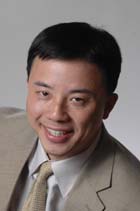Professor Xiang Zhang
The Scientific American article Light bent the wrong way — can an invisibility cloak be far behind? said
“Researchers have taken the next step on the road to constructing a cloak of invisibility or a powerful ‘superlens’ capable of capturing fine details undetectable to current lenses. A group from the University of California, Berkeley, this week is publishing the first demonstrations of materials capable of bending visible or near-visible light the ‘wrong’ way in three dimensions.Both are examples of metamaterials — specially designed structures that cause light to do things it normally wouldn’t — in this case, bending backward, an effect called negative refraction. Researchers have built metamaterials capable of negatively refracting microwaves, but despite some successes bending visible light in two dimensions, they’ve had a harder time making three-dimensional versions.
In a study to be published in Nature, the Berkeley group led by Xiang Zhang, bent red light using a fishnet-shaped stack of 21 layers of silver and magnesium fluoride, each a few tens of nanometers thick (see diagram). (One nanometer is a billionth of a meter.) The group will also report in Science that it bent near-infrared light using a thinner sheet of aluminum oxide containing silver nanowires. The researchers believe the second material ought to work on red light as well.”
Xiang Zhang, Ph.D. is Chancellor’s Professor at UC Berkeley and the Director of the NSF Nano-scale Science and Engineering Center (NSEC) which includes Berkeley- Stanford-UCLA-UCSD-UNCC. He also serves as Director of the Department of Defense MURI Center on Metamaterials and Devices that includes Berkeley-MIT-UCLA-UCSD-Duke- Imperial College (UK).
Xiang’s current research focused on nano-scale science and technology, meta-materials, nano-photonics, and bio-technologies. He has published more than 80 technical papers including publications in Science and Nature Materials. He has given over 80 invited or keynote talks at international conferences and institutions. He is on the editorial boards of three journals. He is a co-chair of NSF Nanoscale Science and Engineering Annual Grantee Conference in 2004–2005 and Chair of Technical Program of IEEE 2nd International Conference on Micro and Nano Engineered and Molecular Systems in 2007.
His research has been selected to be one of Top Ten Nanotechnology Breakthroughs in 2005, and Fast Breaking Papers, as one of the most cited recent papers in Physics in 2006, and R&D Magazine’s “Top 25: The Most Innovative Products” of 2006. He was selected as a Finalist for the 2005 Small Times Magazine 2005 Small Tech Best Researcher Award. His research is frequently featured by media such as MRS Bulletin (Materials Research Society), Laser Focus World, Photonics Spectra, Materials Today, Physics Web, San Jose Business Journal, R&D Magazine, as well as international media including BBC News, UK, Better Humans, Canada, and The Hindu, India.
Xiang is a recipient of the NSF CAREER Award (1997), Engineering Foundation Award (1997), SME Dell K. Allen Outstanding Young Manufacturing Engineer Award (1998), and the ONR Young Investigator Award (1999). He was nominated in 2004 for the Millennium Technology Prize, the world’s largest technology award. He was selected as a “Distinguished Lecturer” at University of Texas at Austin in 2004 and SEMETECH in 2005.
He coauthored Creation of a magnetic plasmon polariton through strong coupling between an artificial magnetic atom and the defect state in a defective multilayer microcavity, Three Dimensional Optical Metamaterial Exhibiting Negative Refractive Index, A hybrid plasmonic waveguide for subwavelength confinement and long range propagation, Plasmon-Induced Transparency in Metamaterials, Superlenses to overcome the diffraction limit, Cloaking of Matter Waves, Magnetic plasmon modes in periodic chains of nanosandwiches, and Super-Resolution Imaging by Random Adsorbed Molecule Probes. Read the full list of his publications!
Xiang earned his Ph.D. in Mechanical Engineering from UC Berkeley (1996) and his MS/BS in Physics from Nanjing University, China. He was an assistant professor at Pennsylvania State University (1996–1999), and associate professor (1999–2003) and full professor (2003–2004) at UCLA prior to joining the Berkeley faculty in 2004. He is also a member of the NASA Institute of Cell Mimetic Space Exploration (CMISE) and member of the Berkeley Nanoscience and Nanotechnology Institute (BNNI).
Watch Xiang on CNN. Read Promising new metamaterial could transform ultrasound imaging, Goal of nanoscale optical imaging gets boost with new hyperlens, and UC Berkeley Researchers Look to Shrink Optics by “Squeezing” Light.
